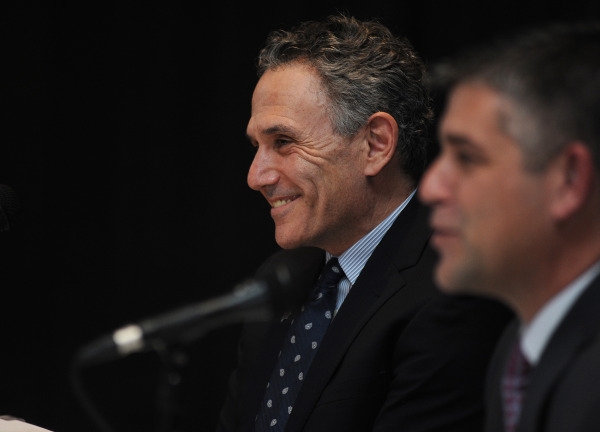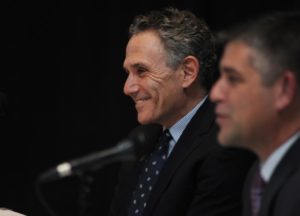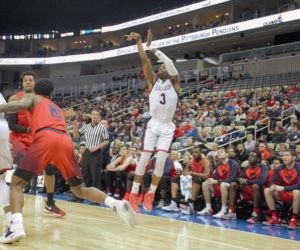

Adam Lindner | Sports Editor
11/09/2017
On March 8 at PPG Paints Arena in the opening round of last season’s Atlantic 10 Men’s Basketball Championship, No. 14 Duquesne led No. 11 Saint Louis by 18 points with 15 minutes remaining in regulation.
Pretty sweet, considering the Dukes, 3-15 in conference play last season, had managed to win a modest two games dating back to the beginning of the calendar year.
Furthermore, Jim Ferry-led Duquesne teams seemed unable to shake various afflictions during his tenure, and mismanaging late-game situations had become a reoccurring theme for the team.
So of course, the Dukes’ 18-point lead would vanish as Saint Louis guard Davell Roby scored on a putback layup in the game’s final seconds, giving the Billikens a 72-71 lead with :01.6 remaining.
Duquesne graduate transfer forward Kale Abrahamson released a final heave ahead of the buzzer’s sounding to no avail, and the Dukes dejectedly exited in defeat for what would prove to be their last game under Ferry.
A fine recruiter, Ferry was able to lure both Mike Lewis II and Isaiah Mike to the Bluff last fall, and several 2017 quality prospects were committed to Duquesne ahead of Ferry’s dismissal.
Nevertheless, despite impressive recruiting gems in both Lewis and Mike, athletic director Dave Harper saw it fit to relieve Ferry of his duties as Duquesne’s head coach on March 13.
One former Ferry commit — point guard Jamari Wheeler of Live Oak, Florida — is now reunited with Ferry at Penn State, where Wheeler eventually chose to attend following Duquesne’s decision to switch coaches, and where Ferry is now an assistant coach under Pat Chambers.
In five seasons at Duquesne, Ferry recorded a 60-97 record, including an even more cringe-worthy 21-65 tally in the Atlantic 10.
Nonetheless, despite a gut feeling that the program needed a hard reset, it seemed to many as if Duquesne had shot itself in the foot by firing Ferry in the ensuing weeks as administration struggled to find a replacement.
A plethora of potential coaching targets publicly denied having interest in the Duquesne position for what seemed like weeks on end, leading sports journalist Mark Titus to comically campaign for himself on ESPN’s SportsCenter to become the Dukes’ next coach.
Meanwhile, Mike, Lewis, Nakye Sanders, Rene Castro-Caneddy and Spencer Littleson all announced their intentions to gauge interest from other programs, temporarily leaving Tarin Smith as the Dukes’ lone contributing piece remaining on the roster throughout the whole offseason.
That said, nobody could have expected that over half of a year later, Duquesne’s program would be able to overcome monumental roster turnover and generate more positive momentum than crosstown rival Pitt days before the beginning of college basketball’s regular-season.
Since his lucrative hiring on March 30, Keith Dambrot has gained Lewis’ favor and managed to convince Castro-Caneddy to remain at Duquesne despite the opportunity to leave as a graduate transfer and play immediately elsewhere.
What’s more, Dambrot has won over the locker room and the fan base before coaching a single game, effectively breathing a breath of fresh air into a weary A.J. Palumbo Center.
“They were both good coaches,” a men’s player told The Duke of both Ferry and Dambrot, “but Dambrot is [much] more personable.”
In a short time, Dambrot has awoken a comatose program and crafted it into one eager for the future, especially equipped with a particular thirst for the NCAA tournament — something that Duquesne hasn’t reached since 1977.
No matter all of the hopeful excitement that Duquesne fans may have stored in the future, the Dukes will begin their 2017-18 regular-season slate at 5:30 p.m. on Nov. 11 versus St. Francis N.Y. at the Palumbo Center with a scanty eight healthy scholarship players, with reinforcements coming soon in sophomore Kellon Taylor, graduate transfer Chas Brown, and junior college transfer Marko Krivacevic.
Taylor splits time as both a forward and wide receiver for Duquesne’s basketball and football teams, and Brown will be sidelined until early December with a stress fracture, which is around the same time Krivacevic should return from a broken wrist, per Dambrot. Taylor will join the basketball team following the end of the football team’s season.
No matter how badly Duquesne may lack depth early on this season, Dambrot said that he’s fine with Taylor remaining away from the court for now — as long as it’s due to winning in the postseason on behalf of the football squad.
FCS playoff success for Jerry Schmitt’s team or not, Dambrot heads into his first season at the helm of his father’s alma mater’s basketball program extremely thin on bodies.
Despite a thin back court, talented sophomore Mike Lewis — Duquesne’s leading scorer averaged 14.1 points per game last season — will rejoin forces with fellow returning starter Tarin Smith, who transferred to the Bluff from Nebraska in 2015 and led the Dukes with both 99 assists and 34 steals last year.
In addition to Lewis and Smith, streaky scorer Rene Castro-Caneddy returns after averaging 7.1 ppg in 29 games last season, highlighted by a 26-point outing in a victory over Saint Francis Pa. on Nov. 16.
Led by Lewis, Duquesne’s three returning guards must improve upon their output from last season’s campaign for the Dukes to compete in the A-10 this season.
While Lewis is Duquesne’s best shooter, he will also facilitate the offense for Dambrot a vast majority of the time. Smith’s biggest strength is driving to the rim, which is something that Duquesne’s guards must resist the urge to do at an excessive clip, according to Dambrot.
Dambrot explained following Duquesne’s hurricane relief exhibition game versus D-III Chatham on Nov. 1 that, while driving to the rim aggressively has its time and place, his staff will be looking to see this year’s primary ball-handlers feed big men on the block more frequently this season in an attempt to control tempo, cut down on turnovers, and make the most of each offensive possession.
Joining Lewis, Smith and Castro-Caneddy in the backcourt is true freshman Eric Williams Jr., who was Dambrot’s first high school recruit to commit to the coach at Duquesne.
Of New Haven, Michigan, the 6-foot-5 Williams will bolster Duquesne’s guard set with length and athleticism, which the rookie put on display during a Nov. 1 exhibition win in catching and dunking several alley-oop passes over undersized Chatham defenders.
A high-volume scorer in high school, Williams’ aggressive play will help Duquesne score in transition and defend on the perimeter this season.

Due to a lack of depth down low, Dambrot said that he will need his guards to focus on rebounding well this year, too, in order to help offset a lack of size that the team faces this season.
Against Chatham, Duquesne allowed 16 offensive rebounds — something that can’t continue if the Dukes want to have success against the much more athletic teams that they stand to face later on this season.
Jordan Robinson and Tydus Verhoeven headline a shaky cast of forwards down low, equipped with no true offensive presence.
Robinson, a 6-foot-8, 255-pound graduate student, has tallied just 569 career minutes in three years with Duquesne, resulting in a rare mixture of age and inexperience. Robinson’s low-usage rate over the course of his career led Dambrot to deem Robinson “a low-mileage guy” that stands to assume a huge amount of responsibility in his last year of eligibility, thanks in large part to the departures of forwards Mike (transferred to SMU), Sanders (made a lateral move to attend Towson) and Darius Lewis, who graduated.
Fellow senior Eric James will aid Robinson in anchoring Duquesne’s last line of defense.
James, along with Chas Brown, once healthy, will provide Duquesne with much-needed game experience on the blocks.
Brown, a 6-foot-8, 235-pound graduate transfer from Coppin State, was the team’s MVP last season, leading the Eagles in both points per game (12.6) and rebounds per (7.1).
Krivacevic, along with freshmen Verhoeven and Nicholas Kratholm, will look to contribute in any way possible; especially Verhoeven, a defensive marvel who recorded four blocks in Duquesne’s Nov. 1 exhibition victory.
While the coming season figures to be a growing experience for Duquesne, a few storylines are worth following closely, including the play of Lewis in his second season on the Bluff.
If Lewis is able to improve upon his output from last season while helping to orchestrate a young offense this year, Lewis could take the next step toward becoming one of Duquesne’s most memorable names in recent memory.
Another thing to watch for in Dambrot’s debut season is whether or not the Dukes can play a sharper and more consistent game than they have in years past under Ferry.
Losses will be forgiven in the coach’s first go-round if a change in the team’s culture is visibly evident.
If such a culture shift is apparent, the program may be well-suited for a major step forward in as early as Year 2 of Dambrot’s time here, when five transfers will be eligible to play alongside the coach’s first complete recruiting class at Duquesne.
With that said, don’t pin too much on Duquesne’s 2017-18 win-loss count. Especially not once the team hits Atlantic 10 play.
It might not be too pretty.




